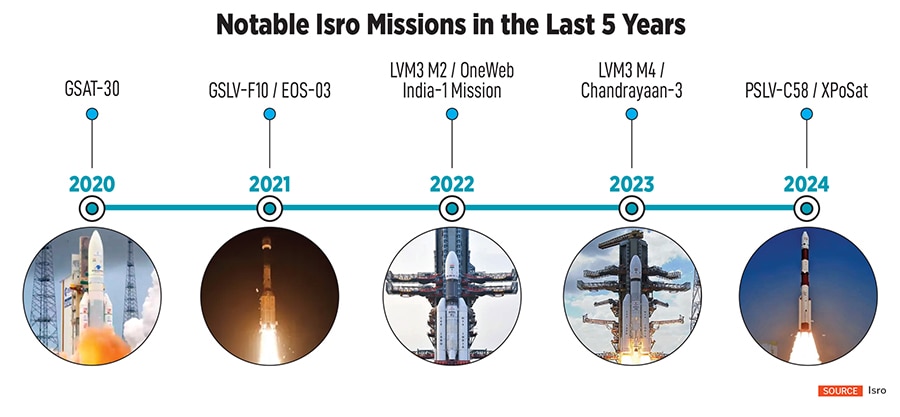One of the immediate reasons for this was the urgent need for greater all-weather surveillance from space after the Mumbai terror attacks of November 2008.
The RISAT-2 was an earth observation satellite equipped with synthetic-aperture radar (SAR) technology. Apart from surveillance, it had applications in agriculture, forestry, soil moisture estimation, and disaster management. SAR technology allowed it to capture high-resolution images.
Fast forward to 2024, on May 1, GalaxEye, a Bengaluru startup, signed a memorandum of understanding (MoU) with the Indian National Space Promotion and Authorization Centre (IN-SPACe), an autonomous agency under the Department of Space, to use Isro’s co-working and testing facilities for the indigenous SAR and MSI (multi spectral imaging) technology it is developing.
“This partnership marks a transformative chapter not only for GalaxEye but for the entire field of space exploration," wrote Suyash Singh, co-founder and CEO of GalaxEye, in a blog after announcing the MoU.
He isn’t off the mark. In future, new generations will look back at this time in the history of India’s space faring efforts to say how Isro fostered the country’s fledgling private space tech ecosystem. This, in the long run, will likely be Isro’s greatest contribution, beyond its own great missions.
GalaxEye is only the latest private, venture capital-funded space-tech startup in India to strike a partnership like this with Isro. From earth observations satellites to satellite launch vehicles to in-space propulsion systems, a whole ecosystem of private space-tech ventures is slowly emerging in India, with Isro’s invaluable support.
Among such startups, Skyroot Aerospace has successfully launch-tested its first technology demonstrator rocket. Agnikul Cosmos is expected to test its first rocket soon.
Bellatrix Aerospace is planning a state-of-the-art factory in Bengaluru to build its in-space propulsion systems. It has put in space the first of these products to demonstrate its capabilities.
In 2023, GalaxEye built India’s first indigenous drone equipped with SAR technology. It is now working on building a private constellation of earth observation satellites. The company is looking at launching its first satellite to be called Drishti Mission in the next 12 months.
This satellite will be India’s first and the world’s highest-resolution multi-sensor imaging satellite, according to GalaxEye.
Over the last 15 years, Isro’s achievements and milestones are nothing short of breathtaking. Some of the noteworthy ones are Chandrayaan-1, GSAT-4, Mangalyaan, the Mars orbiter, GSAT-9, GSAT-19 and GSAT-29, Chandrayaan-2, PSLV-C51/RISAT-1A, and of course the spectacular success of Chandrayaan-3.
Chandrayaan-1 was India’s first mission to the Moon, launched in October 2008, with several major discoveries and data analysis in 2009. It discovered water molecules on the lunar surface.
Chandrayaan-2, launched in July 2019, was an attempt at sending a lander to the lunar surface and search for water ice on the Moon’s south pole. The lander, Vikram, lost communication during the landing attempt, but the orbiter continues to study the Moon.
Chandrayaan-3 wiped away the disappointment of the previous attempt when it put a lander on the Moon and out trundled a rover, named Pragyan, in a flawless execution in August 2023.
With Gaganyaan, India’s first manned mission to space announced in 2018, Isro is targeting a crewed flight in 2025, to demonstrate India’s capability to send humans to space and safely return them. In February, four air force pilots were named to be the astronauts on this mission, which will eventually take three of them to an orbit of 400 km and return them after three days.
Circling back to space tech commercialisation, in February 2017, Isro set a world record by launching 104 satellites in a single mission using the PSLV-C37 rocket. Since then, Isro has offered its capabilities to multiple customers around the world.
![]()
A recent notable launch was when the Indian space agency launched 36 satellites for the UK’s OneWeb, a satellite constellation company backed by investors including India’s Bharti Enterprises.
The launch, in March 2023, was the second such successful commercial launch from India for OneWeb. The launch deal was struck via NewSpace India Limited (NSIL), which is another important part of the story of how Isro’s capabilities are underpinning India’s expansion into global commercial space operations as well.
The launch was a “very important milestone for Isro as we demonstrated the successful launch of the second consecutive commercial payload of OneWeb," said Somanath S, secretary, Department of Space and chairman, Isro. “This launch has created a new record in the Indian space history."
With this launch of LVM3, the rocket that carried the satellites, through NSIL, “Isro is confident of handling many more such launches on demand for both LEO and GEO mission in the future," he added.
The establishment in March 2019 of NSIL, the commercial arm of Isro, as a wholly owned Government of India company under the Department of Space, and IN-SPACe in June 2020 created a powerful combination that set the ball rolling on India’s opening up of Isro to the private sector.
This paves the way for private participants to step up their efforts to partner Isro.

